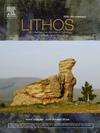High field strength element systematics of rutile in cratonic eclogites: Evidence for NbTa disequilibrium
IF 2.9
2区 地球科学
Q2 GEOCHEMISTRY & GEOPHYSICS
引用次数: 0
Abstract
Recycled oceanic crust sampled as eclogite xenoliths is an important component of cratonic mantle lithosphere. The high field-strength elements (HFSE: Nb, Ta, Zr, Hf, V… etc.) in eclogite xenoliths have been used to trace processes such as melt depletion and metasomatism, and their importance for terrestrial mass balance has been recognized. The accessory mineral rutile is known to concentrate the HFSE in eclogite. However, it is currently unclear if the HFSE are readily equilibrated between eclogitic minerals even at the high temperatures typical of the cratonic lithosphere. To elucidate this issue, here are reported the HFSE systematics of rutile, garnet, and clinopyroxene in twelve texturally well-equilibrated kimberlite-borne eclogite xenoliths from the Slave and West African cratons. Despite its low modal abundance, rutile is the major host for the HFSE Nb and Ta (>95 % of Nb![]() Ta budgets), while other HFSE such as Zr and Hf are mostly hosted in silicate phases (>60 % of Zr
Ta budgets), while other HFSE such as Zr and Hf are mostly hosted in silicate phases (>60 % of Zr![]() Hf budgets). The redox-sensitive element V behaves compatibly in all major minerals making rutile only a minor host of the V budget in the eclogites (<2 %). Within both rutile and silicate grains in both suites of eclogites, Zr and Hf are homogenized on the xenolith scale, whereas Nb and Ta abundances in rutile in eclogite xenoliths from the Koidu kimberlite, but not from the Diavik kimberlite show very large scatter between analyses. Similarly, within- and inter-sample rutile Nb/Ta ratios vary widely in Koidu samples at 14.9 ± 24.3 to 424 ± 463 (Average of grains per sample; 2SD) while Diavik rutile had Nb/Ta only varying between 15.4 ± 0.6 and 90.7 (single analysis). In contrast, average rutile Zr/Hf ratios in each xenolith are more consistent, with Diavik at 33.3 ± 1.3 to 76.3 ± 9.6 and Koidu at 32.0 ± 1.5 to 55.3 ± 7.9 (Average of grains per sample; 2SD). Additionally, Zr
Hf budgets). The redox-sensitive element V behaves compatibly in all major minerals making rutile only a minor host of the V budget in the eclogites (<2 %). Within both rutile and silicate grains in both suites of eclogites, Zr and Hf are homogenized on the xenolith scale, whereas Nb and Ta abundances in rutile in eclogite xenoliths from the Koidu kimberlite, but not from the Diavik kimberlite show very large scatter between analyses. Similarly, within- and inter-sample rutile Nb/Ta ratios vary widely in Koidu samples at 14.9 ± 24.3 to 424 ± 463 (Average of grains per sample; 2SD) while Diavik rutile had Nb/Ta only varying between 15.4 ± 0.6 and 90.7 (single analysis). In contrast, average rutile Zr/Hf ratios in each xenolith are more consistent, with Diavik at 33.3 ± 1.3 to 76.3 ± 9.6 and Koidu at 32.0 ± 1.5 to 55.3 ± 7.9 (Average of grains per sample; 2SD). Additionally, Zr![]() Hf systematics correlate well with indices of melt depletion and metasomatism, indicating equilibrium processes, while the same indices show no correlation with Nb
Hf systematics correlate well with indices of melt depletion and metasomatism, indicating equilibrium processes, while the same indices show no correlation with Nb![]() Ta systematics. The range of Nb/Ta in rutile from Koidu eclogites includes strongly supra-chondritic Nb/Ta ratios (> > 100), which are difficult to explain by typical metamorphic or mantle metasomatic processes. These ratios are here tentatively ascribed to differential diffusion of Nb and Ta from a grain-boundary melt. Disequilibrium is preserved if the last metasomatic event is young relative to xenolith entrainment and if ascent is faster than the timescales required for Nb
Ta systematics. The range of Nb/Ta in rutile from Koidu eclogites includes strongly supra-chondritic Nb/Ta ratios (> > 100), which are difficult to explain by typical metamorphic or mantle metasomatic processes. These ratios are here tentatively ascribed to differential diffusion of Nb and Ta from a grain-boundary melt. Disequilibrium is preserved if the last metasomatic event is young relative to xenolith entrainment and if ascent is faster than the timescales required for Nb![]() Ta equilibration. Studies using Nb/Ta ratios in rutile-bearing samples as petrogenetic tracers must be careful to reconstruct whole rock signatures from a representative number of rutile grains and must carefully screen for Nb
Ta equilibration. Studies using Nb/Ta ratios in rutile-bearing samples as petrogenetic tracers must be careful to reconstruct whole rock signatures from a representative number of rutile grains and must carefully screen for Nb![]() Ta disequilibrium.
Ta disequilibrium.
求助全文
约1分钟内获得全文
求助全文
来源期刊

Lithos
地学-地球化学与地球物理
CiteScore
6.80
自引率
11.40%
发文量
286
审稿时长
3.5 months
期刊介绍:
Lithos publishes original research papers on the petrology, geochemistry and petrogenesis of igneous and metamorphic rocks. Papers on mineralogy/mineral physics related to petrology and petrogenetic problems are also welcomed.
 求助内容:
求助内容: 应助结果提醒方式:
应助结果提醒方式:


